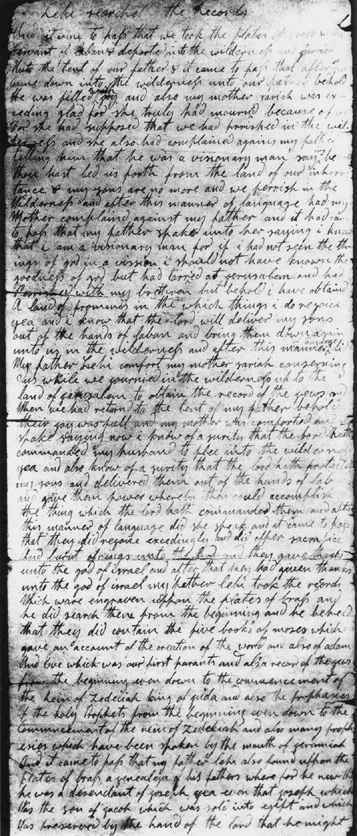
Why would it be important to explore the emergence of the Book of Mormon? My intentions was not to bore my audience with seemingly meaningless stale dates and details. My intention was to set the stage for the following discussion of how to best represent this book to the world.
I believe that the current form of the Book of Mormon, though liberating in its ability for clear, concise communication, stifles audiences' ability to view this work as literature.
The Book of Mormon contains many types of writing including intricate Hebraic poetry, memorable narratives, rhetorically effective sermons, diverse letters, allegory, figurative language, imagery, symbolic types, and wisdom literature (
Encyclopedia of Mormonism). When these literary feats are butchered and confined to verses, the average reader does not pick up on their presence.
Take for example, this passage in 1 Nephi 2:19:
Standard Version:19 And it came to pass that the Lord spake unto me, saying: Blessed art thou, Nephi, because of thy faith, for thou hast sought me diligently, with lowliness of heart.
20 And inasmuch as ye shall keep my commandments, ye shall prosper, and shall be led to a land of promise; yea, even a land which I have prepared for you; yea a land which is choice above all other lands.
21 And inasmuch as thy brethren shall rebel against thee, they shall be cut off from the presence of the Lord.
22 And inasmuch as thou shalt keep my commandments, thou shalt be made ruler and a teacher over thy brethren.
1830's version:And it came to pass that the Lord spake unto me, saying, Blessed art thou, Nephi, because of thy faith, for thou hast sought me diligently, with lowliness of heart. And inasmuch as ye shall keep my commandments, ye shall prosper, and shall be led to a land of promise; yea, even a land which I have prepared for you; yea a land which is choice above all other lands. And inasmuch as thy brethren shall rebel against thee, they shall be cut off from the presence of the Lord. And inasmuch as thou shalt keep my commandments, thou shalt be made ruler and a teacher over thy brethren.
Notice how the "voice" of the Lord stays current through the entire passage. In the versified version, His voice seems to get lost with each progressing segment.
Modern VersionNotice how though the words stay the same, the form changes and thus changes the meaning of the words:
And it came to pass that the Lord spake unto me, saying:
Blessed art thou, Nephi, because of thy faith,
for thou hast sought me diligently,
with lowliness of heart.
And inasmuch as ye shall keep my commandments,
ye shall prosper, and shall be led to a land of promise;
yea, even a land which I have prepared for you;
yea, a land which is choice above all other lands.
And inasmuch as thy brethren shall rebel against thee,
they shall be cut off from the presence of the Lord.
And inasmuch as thou shalt keep my commandments,
thou shalt be made a ruler and a teacher over thy brethren.
This new way of viewing the work, bringing the literary overtly back into the text, gives more meaning the words. However, I believe, this can be taken one step further. Bringing the personal voice into this text, through people responding to the characters and lessons taught in the book, will answer President Kimball's challenge for our members to, "...effectively use it as a missionary tool, and let us know how it leads us to Christ and answers our personal problems and those of the world."
 As I have been discussing the emergence of the Book of Mormon, my point has not been to simply present research on a subject which seems unimportant in light of the actual goals of the book. As I have discussed The Book of Mormon's emergence and how it has slowly been flooding the earth, I plan to propose what I believe to be the best way this book can be accessible to all the earth.
As I have been discussing the emergence of the Book of Mormon, my point has not been to simply present research on a subject which seems unimportant in light of the actual goals of the book. As I have discussed The Book of Mormon's emergence and how it has slowly been flooding the earth, I plan to propose what I believe to be the best way this book can be accessible to all the earth. 










